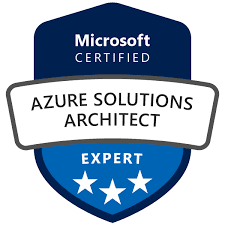Audience
This course is for IT Professionals with expertise in designing and implementing solutions running on Microsoft Azure. They should have a broad knowledge of IT operations, including networking, virtualization, identity, security, business continuity, disaster recovery, data platform, budgeting, and governance. Azure Solution Architects use the Azure Portal and as they become more adept, they use the Command Line Interface.
Candidates must have intermediate-level skills in Azure administration and have experience with Azure development processes and DevOps processes.
Prerequisites
Before attending this course, delegates must have previous experience deploying or administering Azure resources and conceptual knowledge of:
• Azure Active Directory
• Azure compute technologies such as VMs, containers and serverless solutions.
• Azure virtual networking to include load balancers
• Azure Storage technologies (unstructured and databases)
• General application design concepts such as messaging and high availability.
Skills Gained
After completing this course, students will be skilled in:
• Implementing Azure data storage solutions such as Azure SQL Database, Azure Cosmos DB, and Azure Files.
• Implementing Azure SQL Database Managed Instances and service tiers.
• Recommendations for Governance such as Azure Policy and Azure Blueprint.
• Recommendations for subscriptions, accounts, and Role-Based Access Control.
• Designs for Authentication and Authorization such as MFA and hybrid identities.
• Solutions for logging and monitoring such as Azure Monitor and Azure Monitoring solutions (Azure Security Center, Azure Application Insights, and Azure Sentinel).
• Recommendations for intra and intersite integration (name resolution, network security, internet protection, hybrid networks, and perimeter networks).
• Manage network traffic using network routing and service endpoints, Azure load balancer, and Azure Application Gateway.
• Solutions for Application Architecture such as event-based Cloud automation, microservices architecture on Azure Service Fabric, and designs for microservices APIs.
• Recommendations for Azure App Service, Azure Container Instances, and Kubernetes
Course outline
Module 1: Design a Compute Solution
• Lesson 1: Choose an Azure Compute Service
• Lesson 2: Determine Appropriate Compute Technologies
• Lesson 3: Recommend a Solution for Containers
• Lesson 4: Provisioning Solutions for Azure Compute Infrastructure
• Lesson 6: Module 1 Review Questions
Module 2: Design a Network Solution
• Lesson 1: Plan Virtual Networks
• Lesson 2: Recommend a Solution for Network Addressing and Name Resolution
• Lesson 3: Recommend Solutions for Network Security
• Lesson 4: Recommendation for Hybrid Networks
• Lesson 5: Implement a Secure Hybrid Network
• Lesson 6: Module 2 Review Questions
Module 3: Design for Migration
• Lesson 1: Planning Azure Migration
• Lesson 2: Assessment using Azure Migrate
• Lesson 3: Migrate Servers with Azure Migrate
• Lesson 4: Migrate Databases with Azure Database Migration Service
• Lesson 5: Migrate On: Premises Data to Cloud Storage with AzCopy
• Lesson 6: Lab
• Lesson 7: Module 3 Review Questions
Module 4: Design Authentication and Authorization
• Lesson 1: Tips for Identity and Access Management
• Lesson 2: Recommend a Solution for Multi Factor Authentication
• Lesson 3: Five Steps for Securing Identity Infrastructure
• Lesson 4: Recommend a Solution for Single Sign On (SSO)
• Lesson 5: Recommend a Solution for a Hybrid Identity
• Lesson 6: Recommend a Solution for B2B Integration
• Lesson 7: Recommend a Hierarchical Structure for Management Groups, Subscriptions and Resource Groups
• Lesson 10: Lab
• Lesson 11 Module 4 Review Questions
Module 5: Design Governance
• Lesson 1: Governance
• Lesson 2: Recommend a Solution for using Azure Policy
• Lesson 3: Recommend a Solution for using Azure Blueprint
• Lesson 4: Module 5 Review Questions
Module 6: Design a Solution for Databases
• Lesson 1: Select an Appropriate Data Platform Based on Requirements
• Lesson 2: Overview of Azure Data Storage
• Lesson 3: Recommend Database Service Tier Sizing
• Lesson 4: Dynamically Scale Azure SQL Database and Azure SQL Managed Instances
• Lesson 5: Recommend a Solution for Encrypting Data at Rest, Transmission, and In Use
• Lesson 6: Lab
• Lesson 7: Module 6 Review Questions
Module 7: Select an Appropriate Storage Account
• Lesson 1: Choose Between Storage Tiers
• Lesson 2: Recommend Storage Management Tools
• Lesson 3: Module 7 Review Questions
Module 8: Design Data Integration
• Lesson 1: Azure Data Platform End-to-End
• Lesson 2: Recommend a Solution for Data Integration
• Lesson 3: Recommend a Solution for Data Warehousing and Big Data Analytics Integration
• Lesson 4: Module 8 Review Questions
Module 9: Design a Solution for Logging and Monitoring
• Lesson 1: Monitoring
• Lesson 2: Azure Monitor
• Lesson 3: Module 9 Review Questions
Module 10: Design a Solution for Backup and Recovery
• Lesson 1: Architectural Best Practices for Reliability
• Lesson 2: Recommend an Azure Site Recovery Solution
• Lesson 3: Design a Solution for Data Archiving and Retention
• Lesson 4: Module 10 Review Questions
Module 11: Design for High Availability
• Lesson 1: High Availability
• Lesson 2: Applications in Multiple Azure Regions for High Availability
• Lesson 3: Design HA Applications to Handle Disaster Recovery
• Lesson 4: Module 11 Review Questions
Module 12: Design for Cost Optimization
• Lesson 1: Recommend Solutions for Cost Management
• Lesson 2: Recommendations for Minimizing Costs
• Lesson 3: Cost Optimization Checklists
• Lesson 4: Module 12 Review Questions
Module 13: Design an Application Architecture
• Lesson 1: Recommend Event: Based Cloud Automation on Azure
• Lesson 2: Microservices Architecture on Azure Service Fabric
• Lesson 3: Designing APIs for Microservices
• Lesson 4: Lab
• Lesson 5: Module 13 Review Questions
Module 14: Design Security for Applications
• Lesson 1: Security for Applications and Services
• Lesson 2: Recommend a Solution using Key Vault
• Lesson 3: Recommend Solutions using Azure AD Managed Identities
• Lesson 4: Module 14 Review Questions
Schedule
Click on the following link to see the current Course Schedule
Our minimum class-size is 3 for this course.
If there are no scheduled dates for this course, it can be customized to suit the time and skill needs of clients and it can be held online, at a rented location or at your premises.
Click on the following link below to arrange for a custom course: Enquire about a course date







Reviews
There are no reviews yet.